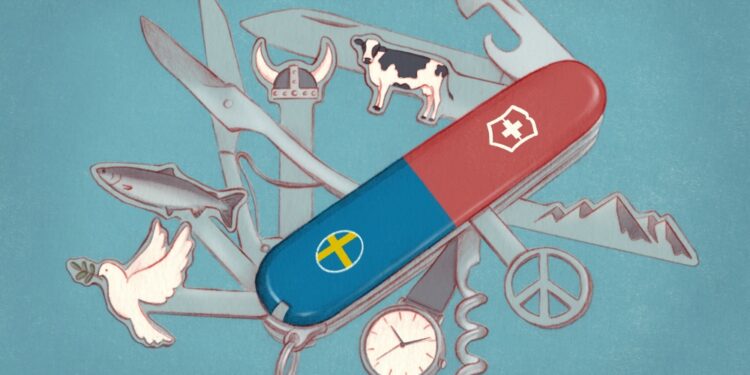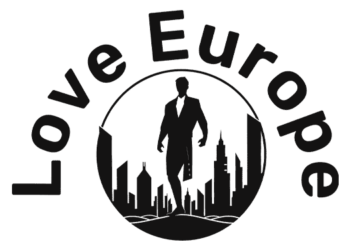Can we, and should we, ever really be neutral? In a new series, Zócalo explores the idea of neutrality—in politics, sports, gender, journalism, and more. For the inaugural essay, Swedish-Swiss journalist Bruno Kaufmann examines how his two famously “neutral” home countries diverge.
For most of my life, people have offered joyful shouts when I have presented either of my passports, or answered the question of where I come from. They have positive associations with my two home countries, Switzerland and Sweden, even if they confused them for each other.
I was born and raised in Switzerland. I have spent most of my adult life in Sweden. So, when I’m pressed to pick between them, I simply answer, “Choose whatever you want.”
That makes some sense, because my countries have some things in common. They are two of Europe’s—and the world’s—oldest and most advanced democracies. For a long time, they also were both neutral countries—but they weren’t neutral in the same way.
Both adhered to the core tenet of neutrality: for at least two centuries, neither engaged in wars. “This commonality sometimes made [the two countries] forget our big differences,” said Jacob Westberg, a professor of war studies and military history at the Swedish Defense University in Stockholm.
But the last few years have changed things for these countries, and for neutrality itself.
This Zeitenwende, or tipping point, began with Russia’s full-scale war against Ukraine in 2022. That same year, Westberg published “How Small States Manage to Stay out of Wars: Explaining Sweden’s 200 Years of Peace,” in which he described the success story of both Sweden and Switzerland (along with other small countries) as neutral states.
But in 2023, he published a new book called Security Strategies: From Neutrality Policy to the Application for NATO Membership (currently only available in Swedish) that charts Sweden’s path to renouncing neutrality and joining the North Atlantic Treaty Organization (NATO), an organization aligned with U.S. interests.
Sweden was prompted to make the epochal shift of stepping away from neutrality by Russia’s invasion of Ukraine and Putin’s threats against Europe. On March 7 of this year Sweden became a NATO member.
That means that Sweden is no longer a neutral country. (I repeat, for those who confuse the two, Sweden is no longer a neutral country. President Joe Biden mistakenly announced that “Switzerland” wanted to join NATO.)
So, my two countries are parting ways. Neutrality no more, says Stockholm, teaming up with Washington, while Bern clings to its successful formula—for now.
But this divergence isn’t a surprise because of the different visions of neutrality that Switzerland and Sweden have long held. This divergence stems from three big differences—those of history, practice, and geography.
As Sweden applied to NATO, and as Switzerland continued on its neutrality track, I started feeling new tension between my countries.
First: History. Switzerland and Sweden both ended their warmongering at the 1815 Congress of Vienna, where “neutrality” for the first time entered international law. But the countries had distinct rationales for laying down their arms.
For centuries, Swedish monarchs had tried to defend their kingdom by engaging in foreign wars against their neighbors. They finally abandoned this strategy after losing Finland and being defeated by Russia in 1809.
Switzerland, meanwhile, was never an imperial power. After it lost its final battle abroad just over the border in northern Italy in 1515, the states of the old Swiss confederation spent centuries engaged in searching for balance domestically.
This internal scrutiny ended at that same Congress of Vienna. That was when Tsar Alexander I of Russia proposed that Switzerland, which at that time was a federation of 22 states, become a neutral country. Together they later funded modern “Switzerland” with a central government, an army, and its own currency. It’s been that way ever since.
Second: Practice. Over the centuries, Switzerland and Sweden developed very different forms of military neutrality. In the Swiss case, according to former president and foreign minister Ignazio Cassis, neutrality was based on the Hague Principles, which include “no participation in wars; international cooperation but no membership in any military alliance; no provision of troops or weapons to warring parties and no granting of transition rights.”
This comprehensive approach to neutrality kept Switzerland not only out of military alliances but also outside international organizations. Switzerland only joined the United Nations in 2002, and only by referendum. Switzerland is still not a member of the European Union.
Where the Swiss approach is sometimes called “integral,” Sweden’s version of neutrality involves what’s termed the “differential approach.” Sweden might foreswear wars, but it had a very active foreign policy. Sweden was a founding member of the United Nations in 1946 and joined the European Union in 1994, after a vote of the people.
Third: Geography. Look at any map, and you’ll see few reasons to confuse my two home countries.
Switzerland occupies a tiny landlocked area of approximately 41,000 square kilometers in the heart of continental Europe. This is bigger than Maryland but smaller than West Virginia. It is encircled by friendly democracies, of which all but one—the micro-state of Liechtenstein—belongs to the European Union.
Sweden has more territory to defend, and less friendly neighbors—specifically, Russia. Located in the far north of Europe, the country expands over an area of more than 450,000 square kilometers, making it slightly larger than California. It shares a maritime border, the Baltic Sea, with Russia, which maintains large military bases in Baltiysk (in the exclave of Kaliningrad) and outside St. Petersburg. In addition, the main Swedish island of Gotland is surrounded by international waters that are used by Russian military vehicles.
All these factors have given the two countries different tipping points on neutrality.
After Russia’s full-scale attack against its neighbor Ukraine on February 22, 2022, then-Swedish Prime Minister Magdalena Andersson initially rejected calls for a change to its neutral position.
“If Sweden were to choose to send in an application to join NATO in the current situation, it would further destabilize this area of Europe and increase tensions,” she told me and other reporters on March 8, 2022.
But just a few weeks later, her declaration was replaced by the announcement—in a historic press briefing held together with then-Finnish Prime Minister Sanna Marin—that both Nordic countries would apply for full NATO membership at the same time.
(That the formerly neutral Finland was accepted much earlier to NATO than Sweden is a story for another time, also based on history, practice, and geography).
As Sweden applied to NATO, and as Switzerland continued on its neutrality track, I started feeling new tension between my countries. On television, Swedish commentator Edward af Sillén expressed profound annoyance at the Swiss decision to make the anti-war song “Watergun” its official 2023 entry to the Eurovision Song Contest. Then in late 2023, the Swedish tourist board started a global campaign intended to make the world understand that Sweden is not Switzerland. Of course, with Sweden having joined NATO in March, any confusion about which of my two home countries is which should be over. At least for the time being.
Source link : https://www.zocalopublicsquare.org/2024/05/08/sweden-pretending-switzerland-neutral/ideas/essay/
Author :
Publish date : 2024-05-08 07:00:00
Copyright for syndicated content belongs to the linked Source.


